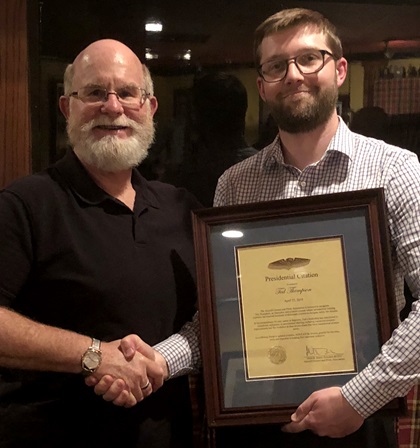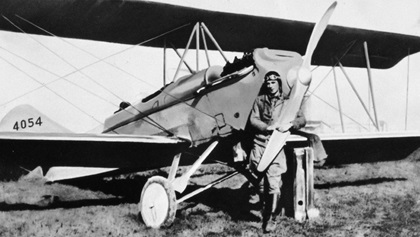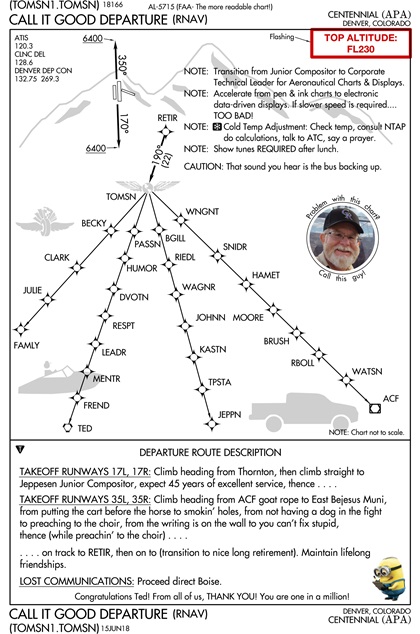Off the charts
Jeppesen's Ted Thompson 'calls it good'
Imagine being so good at making a product for your own use that the company you work for scraps the version it makes for its employees and buys yours instead.
That, in a nutshell, is how one of the best-known companies in the aviation navigation business got started. It doesn’t hurt the almost mythical quality of the company’s creation story that the business traces its lineage back to the era of barnstormers and biplanes piled heavy with mail sacks and flown by pilots who found their way using road atlases or handmade, pen-and-ink charts.
For 84 years, aviation information solutions company Jeppesen, based in Englewood, Colorado, and a Boeing subsidiary since 2000, has grown from such beginnings. For more than half that time, Ted Thompson, Jeppesen’s corporate technical leader, was a key player steering the company into a digital future.

When Thompson retired last spring, perhaps the most fitting of his tributes was an honorary standard instrument departure chart drawn up for him by his colleagues. The “Call It Good Departure” maps out a route with a “transition to nice long retirement,” and contains a clearance to “maintain lifelong friendships.”
Starting out in 1973 as a junior compositor for $2.50 an hour, and honing skills learned from Jeppesen’s original master craftspeople, Thompson completed his career as Jeppesen’s “first-ever and only Corporate Technical Leader for Aeronautical Charts and Displays worldwide.” If you have ever navigated by a “Jepp chart” or Jeppesen database product, Thompson helped you get where you were going safely. His contributions to navigation earned him an AOPA presidential citation, presented to him at his final meeting as a member of the FAA’s Aeronautical Charting Forum, the group that establishes navigation chart specifications.
“Ted has been a true ally and advocate for all aviators. His passion and professionalism are truly appreciated and will be missed by the general aviation community," said AOPA Senior Director of Airspace, Air Traffic, and Aviation Security Rune Duke, who represents AOPA on the Aeronautical Charting Forum and presented Thompson with the citation.
I spoke to Thompson by phone as he was still acclimating to simple retirement pleasures like sipping coffee on the porch with no meetings or publishing deadlines on his schedule; I listened as he reflected on aerial navigation’s evolution from printed airway manuals and charts to GPS instrument approach plate overlays, then stand-alone GPS approaches, and the digital databases of today’s navigation mainstream.
Captain Jeppesen
For me, the leisurely conversation was an opportunity to ask wonky questions about charting IFR procedures. But more than that, it was a chance to steer the narrative back to barnstorming and biplanes and overstuffed mail planes, one of which was flown by the company founder, Elrey Borge Jeppesen.
I learned to my delight that Thompson not only knew the Jeppesen legend, he knew the man.
Jeppesen, born in 1907, barnstormed his way to earning a living in aviation, and his later efforts to make flying safer for fellow airline pilots by gathering all available information about things you could bump into in flight grew into the company whose products are now relied on, as Thompson’s former title affirms, worldwide.
Jeppesen was long retired by the early 1990s, by which point Thompson had come to know him. When ceremonial occasions brought the retiree to the company offices, it had become customary for someone to “bring Captain Jeppesen into my office and ask, ‘Can he sit with you until his ride comes to pick him up?’” (Thompson recalled that the first time it happened, Jeppesen said, “Well, son, you got stuck with the old-timer, didn’t you?”)

Jeppesen “could have been anybody’s grandpa. He loved to talk about his life story,” Thompson said. Their friendship flourished in the years before Jeppesen died in 1996.
If you don’t know about Jeppesen beyond the brand name, and you love aviation history, take time to fill in the blanks. For starters, the website of the National Aviation Hall of Fame contains a brief Jeppesen biography, commemorating his 1990 enshrinement.
“At the age of 23, Jeppesen realized that more information was necessary to make flying easier and safer. He started to compile information from any place he could: city and county engineers, surveyors, farmers, road maps and from his own mountain and smokestack climbing,” it says.
The biography explains how Jeppesen, whose flying career would progress from barnstorming to aerial-survey work, flying the mail, and transport flying for United Airlines, blazed new trails in navigation. He “started writing down all of the important information in a 10-cent, loose-leaf notebook. He highlighted landmarks, elevations of obstructions and airport runway information to help him on his mail runs. After several of his fellow pilots expressed interest in this valuable information, Jeppesen decided to print copies of the material and allow his friends to buy the manual for $10 each. In 1936, he married his sweetheart Nadine and together they worked on the charts out of their basement in Salt Lake City.”
By 1941 the business outgrew the basement, and the Jeppesens moved to Denver. “Jeppesen continued to fly for United while the manual business was growing. The company was printing its own charts at the time, but the pilots usually wound up using the Jeppesen charts. Eventually, United bought Jeppesen’s service for their pilots.”
Jeppesen left the airline in 1954 to focus on charts full time, remaining active even after he sold the business to Times Mirror Co. in 1961, according to the biography.
In 2000, when Boeing acquired the company from Tribune Co., which had bought Times-Mirror, Jeppesen Sanderson Inc. was valued at $1.5 billion.
Finding south
If you have ever looked down from an aircraft cockpit in iffy weather and seen the reassuring sight of a town’s name painted on a roof or a water tower, you have flown a mile in the shoes of the early mail pilots.
Here’s a navigator’s tip your flight instructor probably never told you: If he became disoriented, Jeppesen confided to Thompson, he would look for a farm or ranch, then spot the outhouse.
“Outhouse doors always faced south.”

In 1995, the new Denver International Airport opened. One of its features is a 1.5 million-square-foot Elrey B. Jeppesen Terminal. Thompson recalls that following a ceremony at the airport, someone asked Captain Jeppesen if he would like them to call a taxi for him. Jeppesen replied, “I’d rather ride with Ted.”
Invited into Jeppesen’s home, Thompson was led to the basement, where he was shown some of Jeppesen’s personal memorabilia: “The first charts, plotters and contraptions, old photographs.” More Jeppesen artifacts are on display in the terminal that bears his name, Thompson said.
From that vignette our phone conversation snaps back to the present moment, which feels like a giant leap, but nothing like the jump Thompson took in a career stretching from “the traditional Airway Manual” to establishing a complete digital library that would become “the essential content of today’s electronic flight bags.” Along the way, that journey was marked by helping develop the first generation of computer graphics, collaborating with the FAA on its earliest efforts to bring GPS navigation to mainstream aviation, all part of bringing the old school of navigation and the new together.
Thompson credits the basic understanding he acquired from his mentors—Captain Jeppesen’s “original hires”—with giving him the tools to keep pace with navigation’s growth as each astonishing new technological evolution arrived. But even four-and-a-half decades seems too fleeting a period for one person to accomplish that.
“People ask me how I learned everything I learned,” he said. “I had some really good teachers, and I just paid attention.”



